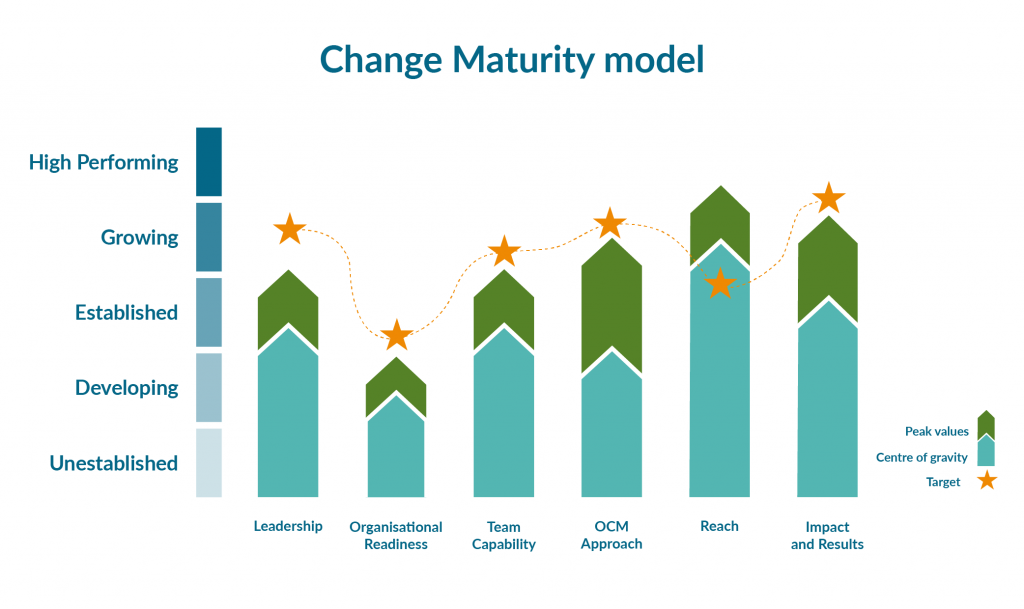By Raylene Armstrong, Managing Partner.
Organisational Context
Over the decade we have seen the internal and external backdrop that organisations are operating in transform exponentially, creating an acceleration in the level of change needed and being undertaken.
These shifts have resulted in a bigger “Call to Action” within organisations to increase relevancy with customers, innovate, improve service and reduce inefficiency plus many others, all while finding opportunities to grow.
The need to respond more quickly and deliver the value for the business has never been more critical. Organisations cannot afford to waste effort and vital resource to miss the benefits and de-motivate their teams.
We are often asked by clients to help them assess their internal change capability and to come up with recommendations to drive the following imperatives.
- Creating an environment where change can flourish and become a constant part of “what we do around here”. (Culture, behaviours)
- How to ensure the changes successfully deliver the desired outcomes. (Competence, Process and Methodology)
Before getting started it is important to be clear on what the organisational challenges are, and what opportunities there are to be solved.
- Need: What is the current climate your organisation is operating under, and is there a high likelihood of the need to make significant transformational changes in the near future?
- Clarify the Goals: What do you want to achieve in terms of building your organisation’s change capability?
- Context: What is your starting point?
There are many business maturity models, but we like to keep things simple considering 2 core elements for assessing the level of change capability, consisting of:
- Core dimensions of change within an organisation
- The extent to which each of these dimensions is embedded in the organisation and working well which determines the overall maturity.
Closer look at the maturity model
The process of helping organisations assess the level of internal change capability takes a number of steps and must be collaborative effort. We generally follow a standard process as follows;

The six dimensions in the maturity model are;
- Leadership: Leaders perceptions, experience and support for change and OCM capability.
- Organisational Readiness: The experience and readiness of the wider organisation for change at a mindset and behavioural level.
- Team Capability: The health and growth of the change capability at an organisational and individual level and how it impacts the success or otherwise of the OCM function.
- Approach: The methodologies, tools, interactions and ways of working to deliver successful change.
- Reach: How broadly the change management approach is used within the organisation.
- Impact and results: How much the OCM team and approach are focused on delivering business benefits and project results and what successes they are having.
To undertake this process well, we encourage speaking with a wide range of colleagues to put an accurate marker in the ground for where the organisation is in terms of change management capability , change outcomes, change management KPIs and their perception as to the level of change capability within their organisation.
Typically, we recommend talking to the following representatives;
- Business leaders
- Change Managers
- Project teams
- Employees who are the recipients of the change
The benefit of taking a 360 perspective and talking to all those involved in driving, delivering and receiving the change helps us to gauge the reality of how well change is really being managed within an organisation
It also highlights the perceived strengths and weaknesses which will form part of the capability build plan.
Insights and recommendation of the Change Maturity Model
In order to convert the results into an actionable plan we plot the mean scores or “Centre of Gravity” for each of the 6 dimensions. We check your centre of gravity against peak performance –
This helps us to determine the overall level of change maturity from unestablished to high performing and for each of the dimensions. Breaking the scores down enables us to zoom in what is working well and where to put more effort to elevate the change capability.
What’s interesting on the graph ( fig 1 below) is where centre of gravity is low, peak performance is the same as target and is high – this means “unleveraged potential”, whereas on a counter point, “your centre of gravity is higher than your target” – in this case “reach” meaning you are stretching yourself too thin for the organization that you are/should be today.
Fig 1.

From this we can generate evidence based insights not only on where the organisation wants to get to but the challenges and opportunities as well as action plans focused first on quick wins with a fast follow on longer term interventions.
The type of recommendations we might discuss are;
- Creating an internal training programme to build change competency, with standardised approaches, templates and other collateral.
- Building on the above creating a mechanism to enable more business representation involved in change projects. Ensuring the right business connection and influence that delivers actionable adoptable change to deliver business value needed.
- Creating a new change business model, which can be entirely made up of internal resource or a combination of both; internal change expertise and external consultants. The latter can work very well to broaden experience but also manage peaks of change.
Talk to us
We would be delighted to hear from you, your thoughts about the assessment dimensions or indeed your own organisations current maturity and whether undertaking an assessment could be beneficial for you.


